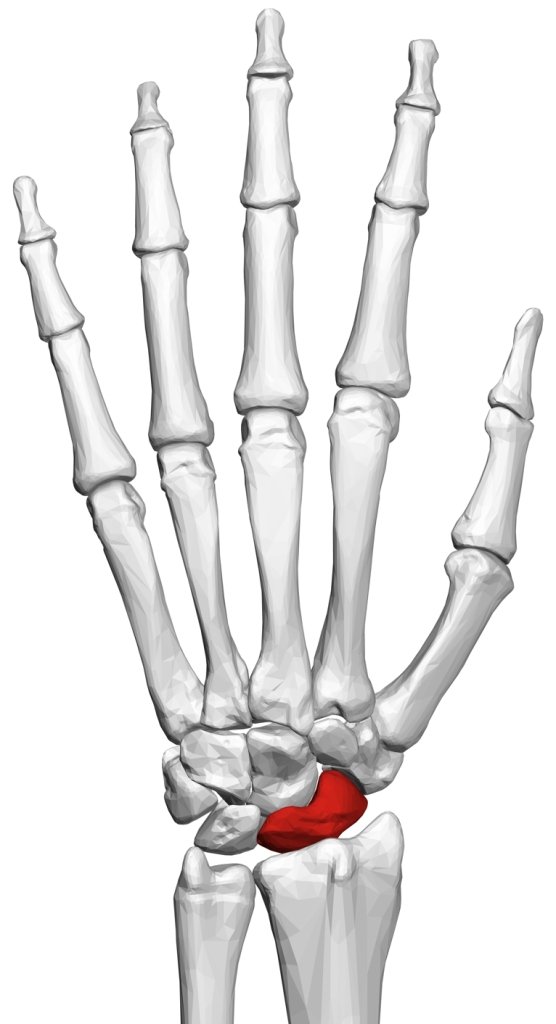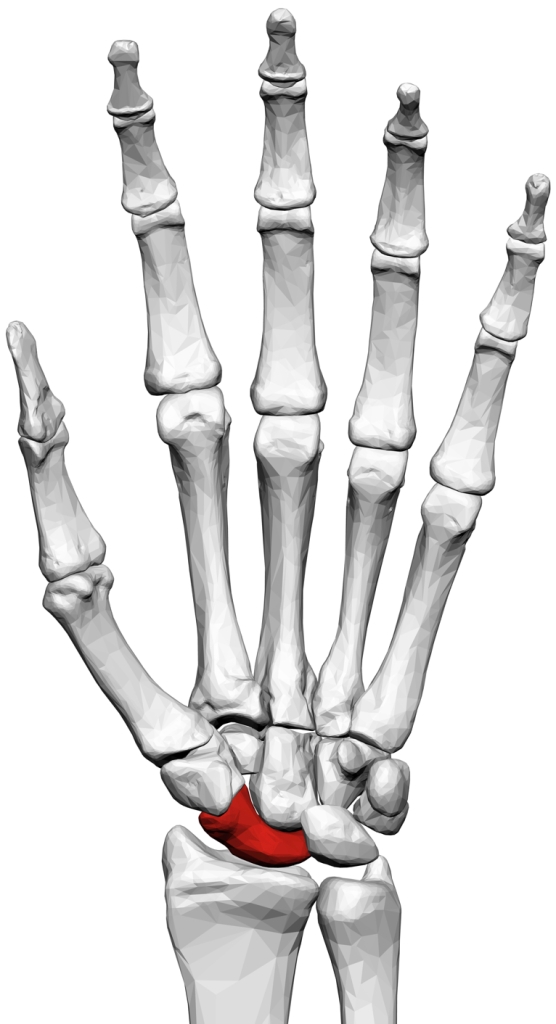Where is the scaphoid bone?
The scaphoid bone is situated on the thumb side of the wrist. It is around the size and shape of a large cashew nut.


Why does a non-union develop?
A non-union is the medical name given when a broken bone does not heal. The scaphoid bone is particularly prone to non-union for 3 main reasons:
1) The fracture is within the wrist joint.
Normally, when a bone breaks, the layer of tissue that envelops the bone (periosteum) is responsible for creating the new bone necessary for healing of the fracture. With the scaphoid bone, most fractures are intra-articular, meaning that they are within the wrist joint itself. Because of this, they do not have periosteum surrounding the fracture, and lubricating fluid from the joint can leak into the fracture. This lubricating fluid tends to prevent normal fracture healing mechanisms.
2) The blood supply to the scaphoid comes in only on one side of the fracture.
Most bones have arteries bring in blood at multiple points. The scaphoid bone is a bit unusual in that the blood supply comes into the bone only on one side, and therefore if the bone breaks, the part of the bone nearest the forearm tends to lose the majority of its blood supply. This makes it difficult for the nutrients required for normal bone healing to reach the scaphoid.
3) Smoking
Unfortunately, smoking is a big factor in preventing bone healing generally, but it is a particular problem with the scaphoid bone because of its tenuous blood supply.

What happens when the bone does not heal?
There are 2 types of scaphoid non-union and each behaves differently:
Fibrous union – This is the name given when the 2 ends of the bone heal with scar tissue rather than with bone. A fibrous union can make the bone move as one piece rather than 2, and in general gives milder symptoms than a non-union without fibrous union.
Pseudoarthrosis – This name is given when the 2 parts of the scaphoid remain mobile and form a ‘joint’ where the bones move relative to each other when the wrist is moved.
What are the symptoms of scaphoid non-union?
The main symptom of scaphoid non-union is persisting pain around the radial or thumb side of the wrist. Around 85% of fractures of the scaphoid heal and around 15% become a non-union. Many patients with a non-union, however, do not seem to develop significant symptoms, and this group of patients may have a fibrous union, or have a variation in the normal mechanics of the wrist which protects against symptoms.
Persisting pain – This is generally the main symptom of a non-union. Nuisance type pain which can be uncomfortable but generally does not interfere with function, is common following a healed scaphoid fracture. Most people with a scaphoid non-union have pain which limits movement and inhibits load bearing with the wrist is common – such as being unable to push up from a chair or to do a press-up.
Weakness of grip – Patients with a non-union almost always lose grip strength compared to the opposite side.
What is the treatment for a scaphoid non-union?
Conservative management – In many patients, particularly where a fibrous union has formed, is is best not to intervene, but accept the position and make changes to modify activity and accommodate the problem. We come across many patients later in life who have an xray for an unrelated problem and have a scaphoid non-union diagnosed that they were completely unaware of. If the situation is stable and there are no symptoms or mild symptoms only, then living with the non-union may be the best option.
Surgery – Where symptoms are causing a problem, surgery is usually recommended. The operation involves taking a piece of bone from either the pelvis or the forearm (from a place where it will not be missed!) and placing it between the ends of the scaphoid bone. Sometimes a vascularised bone graft (a piece of bone with a small blood supply) may be suggested. For some cases, this type of bone graft may aid healing. The bone is then ‘fixed’ with a screw which holds everything in place until the bone heals. The screw is placed inside the bone, and usually stays there forever.

What are the results of surgery?
Despite best efforts, only around 80% of operations to graft and fix a non-union of the scaphoid result in healing of the bone. The most influential factors in terms of healing are the time from injury, age and smoking. These are collectively known as ‘biological factors’. Some ‘mechanical factors’ are also important, such as not overloading the bone while it is healing.
Time from injury – We know that the earlier a non-union is treated with surgery, the better the chance it has of healing. This is not an issue within a year of the injury, but becomes a problem beyond this point. Where a potential non-union is developing, therefore, your surgeon may recommend early operation in order to maximise the chances of union.
Age – As people age, changes in the structure and density of bone may make fixation of the bone impractical because the bone is not strong enough to hold a screw. This is a particular problem for women over the age of 50.
Smoking – Yet another of the adverse effects of smoking is that it reduces the oxygenation of blood, and this impairs healing of bone generally. The vast majority of patients who fail to heal after surgery are smokers, and for this reason we STRONGLY RECOMMEND that you stop smoking prior to non-union surgery.
What are the complications of surgery for a non-union of the scaphoid?
Persistent non-union – This is the most common problem following scaphoid non-union surgery, and affects up to 20% of patients. This is every surgeon’s nightmare, because there is usually no second chance with attempts to get this bone to heal. If the operation fails, then usually the surgeon will recommend no further intervention. Living with a persisting non-union can be challenging and can affect ability to work. If symptoms are severe, then the surgeon may offer a wrist fusion to relieve pain.
Persisting weakness, stiffness and pain – Unfortunately, even when the bone heals, a proportion of patients report ongoing symptoms. Stiffness in the wrist can prevent the ability to do push-ups and the wrist is generally less reliable that it was.
General complications of surgery – you can read about these here.

© Lothian Virtual Hand Clinic 2023